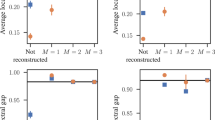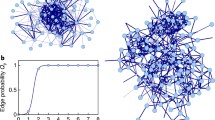Abstract
This chapter is a conceptual look at data quality issues that arise during scientific observations and their impact on social network analysis. We provide examples of the many types of incompleteness, bias and uncertainty that impact the quality of social network data. Our approach is to leverage the insights and experience of observational behavioral scientists familiar with the challenges of making inference when data are not complete, and suggest avenues for extending these to relational data questions. The focus of our discussion is on network data collection using observational methods because they contain high dimensionality, incomplete data, varying degrees of observational certainty, and potential observer bias. However, the problems and recommendations identified here exist in many other domains, including online social networks, cell phone networks, covert networks, and disease transmission networks.
Access this chapter
Tax calculation will be finalised at checkout
Purchases are for personal use only
Similar content being viewed by others
References
E. Adar. Guess: a language and interface for graph exploration. In SIGCHI conference on Human Factors in computing systems, 2006
J. Altmann. Observational study of behaviour: sampling methods. Behaviour, 49:227–267, 1974
F. Aureli, C. Schaffner, C. Boesch, and et al. Fission-fusion dynamics: new research frameworks. Current Anthropology, 48:627–654, 2008
R. Baird and L. Dill. Ecological and social determinants of group size in transient killer whales. Behavioural Ecology, 7:408–416, 1996
R. Baird and H. Whitehead. Social organization of mammal-eating killer whales: group stability and dispersal patterns. Canadian Journal of Zoology, 78:2096–2015, 2000
V. Batageli. Notes on blockmodeling. Social Networks, 19:143–155, 1997
M. Bigg, P. Olesiuk, G. Ellis, and J. Ford. Social organization and genealogy of killer whales (orcinus orca) in the coastal waters of british columbia and washington state. Reports to the International Whaling Commission, Special Issue, 12:383–405, 1990
M. Boguna and R. Pastor-Satorras. Epidemic spreading in correlated complex networks. Physical Review, E 66 4, 2002
Borgatti, Carley, and Krackhardt. Robustness of centrality measures under conditions of imperfect data. Social Networks, 28:124–136, 2006
D. Cai, Z. Shao, X. He, X. Yan, and J. Han. Community mining from multi-relational networks. In Proceedings of the 9th European Conference on Principles and Practice of Knowledge Discovery in Databases, 2005
R. Connor, R. Wells, J. Mann, and A. Read. The bottlenose dolphin, Tursiops sp.: social relationships in a fission-fusion society. In J. Mann, R. Connor, P. Tyack, and H. Whitehead (Eds.), Cetacean Societies: field studies of dolphins and whales, pages 91–126, 2000. The University of Chicago Press, Chicago
P. Domingos and M. Richardson. Mining the network value of customers. In Proceedings of the 7th ACM SIGKDD International Conference on Knowledge Discovery and Data Mining, pages 57–66, 2001
R.W.E.C.G. Owen and S. Hofmann. Ranging and association patterns of paired and unpaired adult male atlantic bottlenose dolphins. Canadian Journal of Zoology, 80:2072–2089, 2002
D. Franks, R. James, J. Noble, and G. Ruxton. A foundation for developing methodology for social network sampling. Behavioral Ecology and Sociobiology, 63:1079–1088, 2009
Frantz and Carley. Relating network topology to the robustness of centrality measures. Technical Report CASOS Technical Report CMU-ISRI-05-117, Carnegie Mellon University, 2005
L. Friedland and D. Jensen. Finding tribes: identifying close-knit individuals from employment patterns. In KDD, 2007
S. Gero, L. Bejder, H. Whitehead, J. Mann, and R. Connor. Behaviorally specific preferred associations in bottlenose dolphins, Tursiops sp. Canadian Journal of Zoology, 83:1566–1573, 2005
Q. Gibson and J. Mann. The size, composition, and function of wild bottlenose dolphin (Tursiops sp.) mother-calf groups in shark bay, australia. Animal Behaviour, 76:389–405, 2008
Q. Gibson and J. Mann. Early social development in wild bottlenose dolphins: sex differences, individual variation, and maternal influence. Animal Behaviour, 76:375–387, 2008
M. Girvan and M.E.J. Newman. Community structure in social and biological networks. PNAS, 99(12):7821–7826, 2002
L. Goodman. Snowball sampling. Annals of Mathematical Statistics, 32:148–170, 1961
Habiba, T.Y. Berger-Wolf, Y. Yu, and J. Saia. Finding spread blockers in dynamic networks. In SNA-KDD, 2008
J. Heer, S.K. Card, and J.A. Landay. prefuse: a toolkit for interactive information visualization. In SIGCHI conference on Human factors in computing systems, pages 421–430, 2005. ACM Press, NY
R. James, D. Croft, and J. Krause. Potential banana skins in animal social network analysis. Behavioral Ecology and Sociobiology, 63:989–997, 2009
H. Kang, L. Getoor, and L. Singh. Visual analysis of dynamic group membership in temporal social networks. SIGKDD Explorations Newsletter, 9(2):13–21, 2007
D. Kempe, J. Kleinberg, and E. Tardos. Maximizing the spread of influence through a social network. In KDD ’03: Proceedings of the ninth ACM SIGKDD international conference on Knowledge discovery and data mining, pages 137–146, 2003
D. Lusseau, B. Wilson, P. Hammond, K. Grellier, J. Durban, K. Parsons, and et al. Quantifying the influence of sociality on population structure in bottlenose dolphins. Journal of Animal Ecology, 75:14–24, 2006
J. Mann. Behavioral sampling methods for cetaceans: a review and critique. Marine Mammal Science, 15:102–122, 1999
J. Mann, R.C. Connor, L.M. Barre, and M.R. Heithaus. Female reproductive success in bottlenose dolphins (Tursiops sp.): life history, habitat, provisioning, and group size effects. Behavioral Ecology, 11:210–219, 2000
J. Moody and D.R. White. Structural cohesion and embeddedness: a hierarchical concept of social groups. American Sociological Review, 68(1):103–127, 2003
M. Newman. The structure and function of complex networks. SIAM Review, 45:167–256, 2003
M. Newman. Detecting community structure in networks. The European Physical Journal B, 38:321–330, 2004
J. O’Madadhain, D. Fisher, S. White, and Y. Boey. The JUNG (Java Universal Network/Graph) Framework, Technical Report UCI-ICS, 03–17
E. Quintana-Rizzo and R. Wells. Resighting and association patterns of bottlenose dolphins (tursiops truncatus) in the cedar keys, florida: insights into social organization. Canadian Journal of Zoology, 79:447–456, 2001
M. Salganik and D. Heckathorn. Sampling and estimation in hidden populations using respondent-driven sampling. Sociological Methodology, 34:193–239, 2004
L. Singh, M. Beard, L. Getoor, and M.B. Blake. Visual mining of multi-modal social networks at different abstraction levels. In Proceedings of the 11th International Conference Information Visualization, pages 672–679, 2007
L. Singh, G. Nelson, J. Mann, A.K. Coakes, E. Krzyszczyk, and E. Herman. Data cleansing and transformation of observational scientific data. In In the ACM SIGMOD Workshop on Information Quality in Information Systems(IQIS), 2006
R. Smolker, A. Richards, R. Connors, and J. Pepper. Sex differences in patterns of association among indian ocean bottlenose dolphins. Behaviour, 123:38–69, 1992
M. Stanton, J. Mann, Q. Gibson, B. Sargeant, L. Bejder, and L. Singh. How much does method matter? a comparison of social networks of bottlenose dolphins (Tursiops sp.) in shark bay, australia. In 18th Biennial Conference on the Biology of Marine Mammals, 2009
C. Tantipathananandh, T. Berger-Wolf, and D. Kempe. A framework for community identification in dynamic social networks. In KDD, 2007
M. Trinkel and G. Kastberger. Competitive interactions between spotted hyenas and lions in the etosha national. African Journal of Ecology, 43:220–224, 2005
A. Wasserman and K. Faust. Social network analysis: methods and applications. Cambridge University Press, Cambridge, 1994
S. Wassermann and P. Pattison. Logit models and logistic regressions for social networks: I. An introduction to markov graphs and p*. Psychometrika, 61:401–425, 1996
Acknowledgement
This work was funded by the Office of Naval Research under grant number #10230702 and the National Science Foundation under grant numbers #0941487 and #0918308.
Author information
Authors and Affiliations
Corresponding author
Editor information
Editors and Affiliations
Rights and permissions
Copyright information
© 2010 Springer Science+Business Media, LLC
About this chapter
Cite this chapter
Singh, L., Bienenstock, E.J., Mann, J. (2010). Perspectives on Social Network Analysis for Observational Scientific Data. In: Furht, B. (eds) Handbook of Social Network Technologies and Applications. Springer, New York, NY. https://doi.org/10.1007/978-1-4419-7142-5_7
Download citation
DOI: https://doi.org/10.1007/978-1-4419-7142-5_7
Published:
Publisher Name: Springer, New York, NY
Print ISBN: 978-1-4419-7141-8
Online ISBN: 978-1-4419-7142-5
eBook Packages: Computer ScienceComputer Science (R0)




